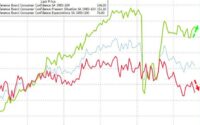Man vs Machine: Investing in Today’s World
 Investors increasingly face an unseen opponent: technology. Often investors believe that technology empowers them. It enables mobile trading. It delivers endless data. What few realize is that technology works against them in many ways.
Investors increasingly face an unseen opponent: technology. Often investors believe that technology empowers them. It enables mobile trading. It delivers endless data. What few realize is that technology works against them in many ways.
Consider that high-frequency trading (HFT) accounts for 70 percent of all equities trading, and that, “fundamental discretionary traders” – people who log in and make a trade like an ordinary human – only account for about 10 percent of all trades according to research from JPMorgan. Market movements have more to do with machines than man.
It’s not surprising to hear the global head of quantitative and derivatives research at JPMorgan warn that, “big data strategies are increasingly challenging traditional fundamental investing and will be a catalyst for changes in the years to come.”
This aspect of equity investing means that an investor’s success is less dependent on their strategy or the intrinsic value of the companies they hold. Instead, the value of their equity portfolio – especially those with short time horizons – are influenced, in part, by HFT activity.
This begs the question; how do investors regain control over their investment performance? For many the answer is gold, and research explains why.
Researcher Joerg Picard wanted to understand how trading influences the value of gold. He reviewed market data and learned that ETF gold trades, which can be traded as easily as HFT equities, “do not contribute much to price discovery.” This conclusion should be reassuring to investors seeking a strategy that is not at the whim of algorithmic trading.
This benefit is especially important in a setting where other influences threaten investment. Inflation is one such threat to the spending power of capital gains. The executive director of precious metals research at Standard Chartered Bank explains that “Various studies have shown us that if gold is held for 12 to 18 months before inflation takes higher and then it’s held for an additional 12 to 18 months while inflation moves higher, it can be a good inflation hedge.”
This assessment underscores an important characteristic of gold; it often serves as a stabilizing force in a portfolio. More investors are seeking this kind of assurance as more uncertainty creeps into the markets. Inflation fears are persistent, and at the same time COVID continues to take its toll on the global supply chain, and geopolitical tensions are on the rise as Putin threatens to make aggressive moves against Ukraine. These reasons might explain why so many analysts are forecasting tepid equity gains for 2022.
Investors have an opportunity to regain control of their portfolio as the pervasiveness of HFT continues to exact influence over the market. As competing investment managers develop more technology in the arms race for a higher return ordinary retail investors face growing challenges. Consider including gold into your asset allocation plan.
Want to read more? Subscribe to the Blanchard Newsletter and get our tales from the vault, our favorite stories from around the world and the latest tangible assets news delivered to your inbox weekly.
[ad_2]
Source link


